

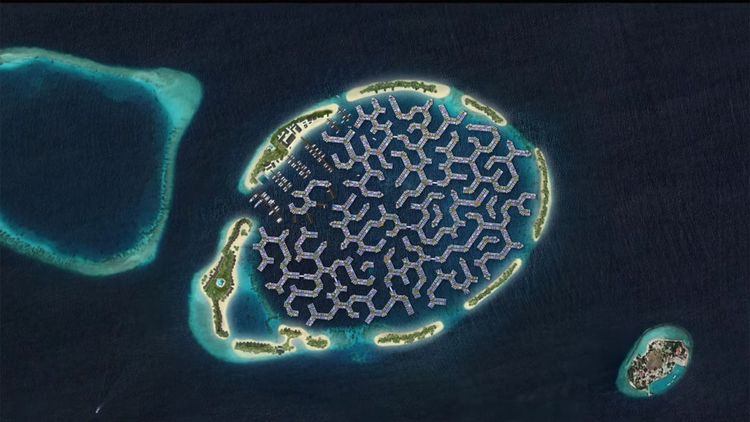
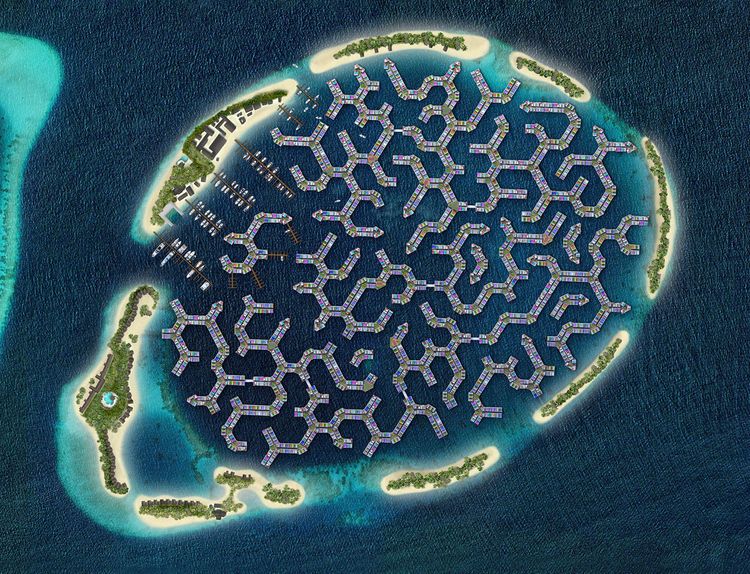
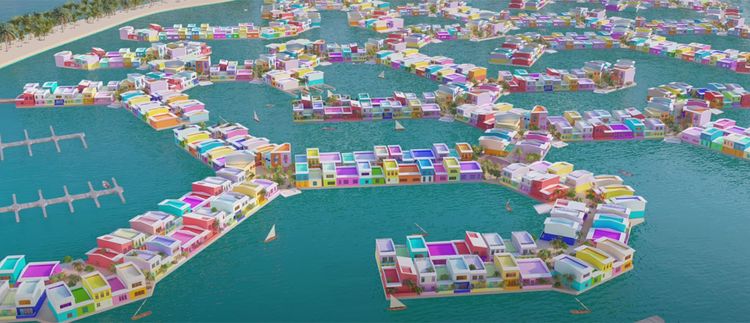
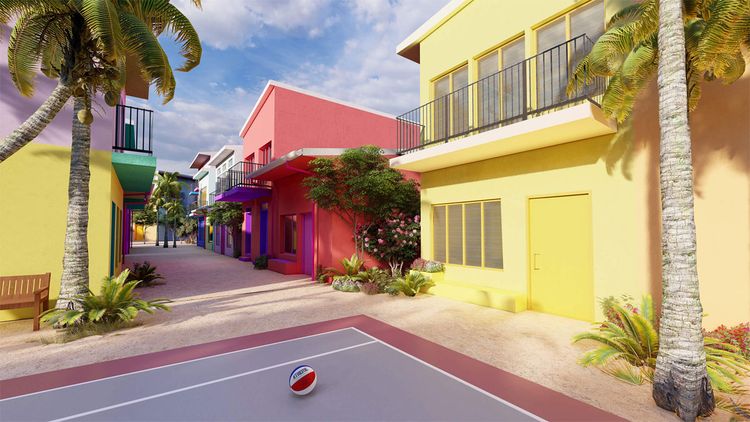
Der Standard
2022.March.13
Auf den Malediven wird die weltweit größte schwimmende Stadt errichtet. Dutch Docklands bauen sie inmitten einer 200 Hektar großen Lagune






By Jonathan Kearney
Maldives Traveller
2022.Feb.28
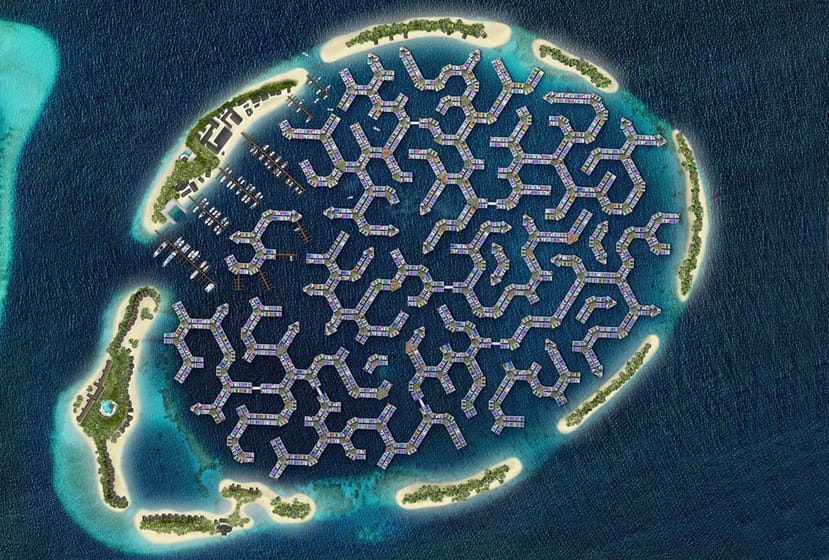
Da der Anstieg des Meeresspiegels auf den Malediven ein heißes Thema ist, schreiten die Pläne für ein einzigartiges und äußerst ehrgeiziges neues Infrastrukturprojekt voran.
Das 1-Milliarde-Dollar-Projekt Maldives Floating City schreitet voran und der Baubeginn ist für diesen Monat geplant.
Das Projekt wird die erste schwimmende Stadt der Welt sein, und die Malediven gelten als ideales Ziel für die Einführung eines solchen innovativen Projekts.
Die 2009 zunächst als Konzept entwickelte Maldives Floating City wird aus rund 5.000 neuen Häusern, zwei Luxusresorts, einem Yachthafen und Einkaufszentren bestehen.
Die schwimmende Stadt, deren Fertigstellung etwa fünf Jahre dauern soll, wird schließlich auch Einrichtungen wie Krankenhäuser, Schulen und Freizeiteinrichtungen umfassen.
Alle Wohnungen werden direkt am Wasser liegen und jeweils zwischen 83 und 140 m² groß sein.
Angesichts des steigenden Meeresspiegels, der die Existenz der Malediven bedroht, soll das Design der schwimmenden Stadt diese Risiken abmildern.
Die schwimmende Stadt wird aus sechseckigen Segmenten bestehen, die die geometrischen Muster der einheimischen Korallen widerspiegeln.
Die Siedlung wird von einem Ring von Barriereinseln umgeben und verbunden sein, die unter Wasser als Wellenbrecher wirken, um die Auswirkungen der Lagunenwellen zu reduzieren und die Strukturen an der Oberfläche zu stabilisieren.
Das Projekt wird von Dutch Dockland durchgeführt, das bereits Tausende von schwimmenden Häusern in den Niederlanden gebaut hat.
Die schwimmende Stadt wird in einer 200 Hektar großen Warmwasserlagune errichtet, die nur 10 Minuten mit dem Boot von der Hauptstadt Male und ihrem internationalen Flughafen entfernt ist.
Die Projektverantwortlichen sagen, dass die Wohnungen in der Siedlung erschwinglich sein werden.
Im Vorfeld der Bauarbeiten, die noch in diesem Monat beginnen sollen, haben die Ingenieure eine Bewertung des Bodens und des Zustands des Riffs vorgenommen.
Es wurde eine Umweltverträglichkeitsprüfung durchgeführt, und das Projekt wurde von der Umweltschutzbehörde genehmigt.
Als niedrig gelegenes Land, das zu 99 % aus Wasser besteht, gehören die Malediven zu den Ländern, die am stärksten vom steigenden Meeresspiegel bedroht sind.
Mehr als 80 % der Fläche des Landes liegen weniger als 1 Meter über dem Meeresspiegel.
Es wird behauptet, dass das Land in den nächsten Jahrzehnten angeblich nicht mehr existieren wird, wenn nicht drastischere Maßnahmen ergriffen werden, um die Auswirkungen des sogenannten Klimawandels zu bekämpfen.
Innovative Projekte wie die schwimmende Stadt sind Teil der kontinuierlichen Bemühungen um ökologische Nachhaltigkeit, da die Malediven nach Lösungen suchen, um die Auswirkungen eines potenziellen Klimawandels zu bekämpfen.
Die Regierung sagt, dass die schwimmende Stadt es den Menschen ermöglichen wird, auf dem Wasser zu leben, ohne die Umwelt zu beeinträchtigen, anstatt Land neu zu gewinnen. Es werden zudem neue Riffe gezüchtet, die als Wellenbrecher für die Entwicklung dienen sollen.
Ein Netz von Brücken, Kanälen und Docks wird den Zugang zu den verschiedenen Segmenten ermöglichen und Geschäfte, Wohnungen und Dienstleistungen in der Lagune auf umweltverträgliche Weise miteinander verbinden.
Erneuerbare Energiequellen werden die schwimmende Stadt mit Strom versorgen, ganz im Sinne des Ziels der Regierung, die Malediven bis 2030 zu einer Nation mit null Emissionen zu machen.
Sun Mediagroup
2022.Feb.12
Bison Maldives has signed a contract with Dutch Docklands Maldives to build the first homes in Maldives Floating City.

Maldives Floating City is a new floating development of 5,000 homes. Being built in a lagoon a five-minute speedboat ride away from Male’ City, designed by Waterstudio.
Bison Maldives signed the contract for the construction of the first homes under the project on Wednesday, February 9.
Bison Maldives said the first homes will be ready after Ramadan, and tours for members of the general public will commence shortly afterwards. Offering a real world look and feel for the new housing development.
The company said the homes were being built locally, to specifications designed by Dutch engineers.
Maldives Floating City uses the latest technology the Netherlands, where engineers have already completed floating housing projects.

Bison Maldives said the 5,000 homes will be tethered to the lagoon floor. And linked together to create a safe and comfortable environment.
Founder and Managing Director of Bison Maldives, Abdul Majeed said the company was delighted to be part of the ground-breaking housing project.
“Bison Maldives is delighted to be part of this ground-breaking housing project and we look forward to delivering the first homes on time,” he said.
Meanwhile, Maldives Floating City’s Director Ibrahim Riyaz said they looked forward to taking members of the public to see the first homes.
“We are excited to start the physical construction of Maldives Floating City. After months of painstaking legal and technical work to prepare for this world class and affordable housing development. I look forward to taking members of the public to the first houses, so they can see the project for themselves. In such an innovative development, seeing is believing,” he said.
click here for source website
click here for the project



さまざまなフローティングアーキテクチャを手がけるオランダの設計事務所Waterstudio.NLのケーン・オルトゥイス(Koen Olthuis)とディベロッパーであるダッチ・ドックランズ(Dutch Docklands)が、ジャッキアップ技術を活用したフローティングヴィラ〈Arkup〉を発表しました。
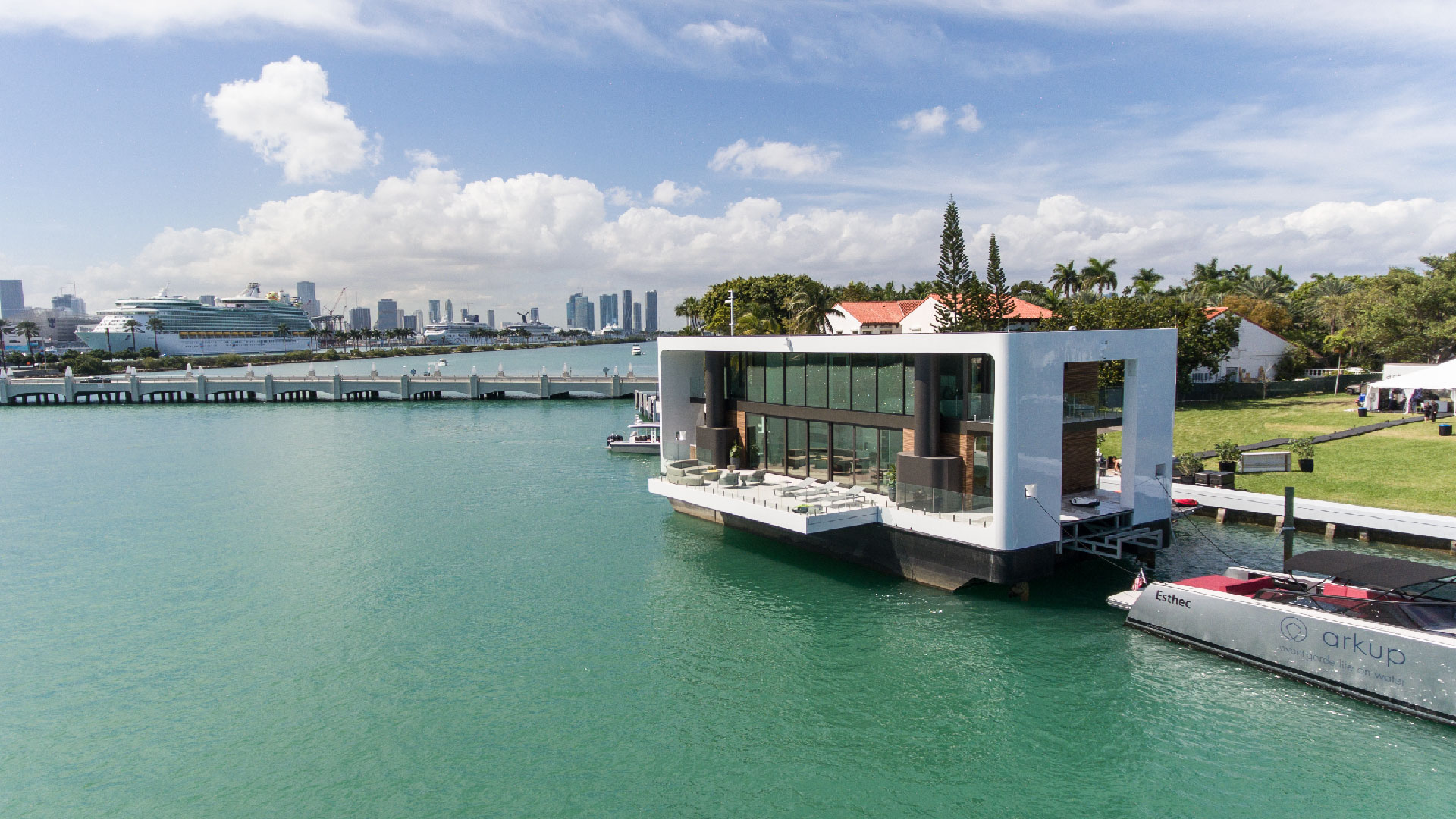

貿易の利便性から世界の大都市の約90%が沿岸部に位置しています。そして沿岸部は地球の地表面積のうち2%ほどにもかかわらず、世界人口の約10%が居住しており、今後も増加し、2050年には14億人に達すると見込まれています。
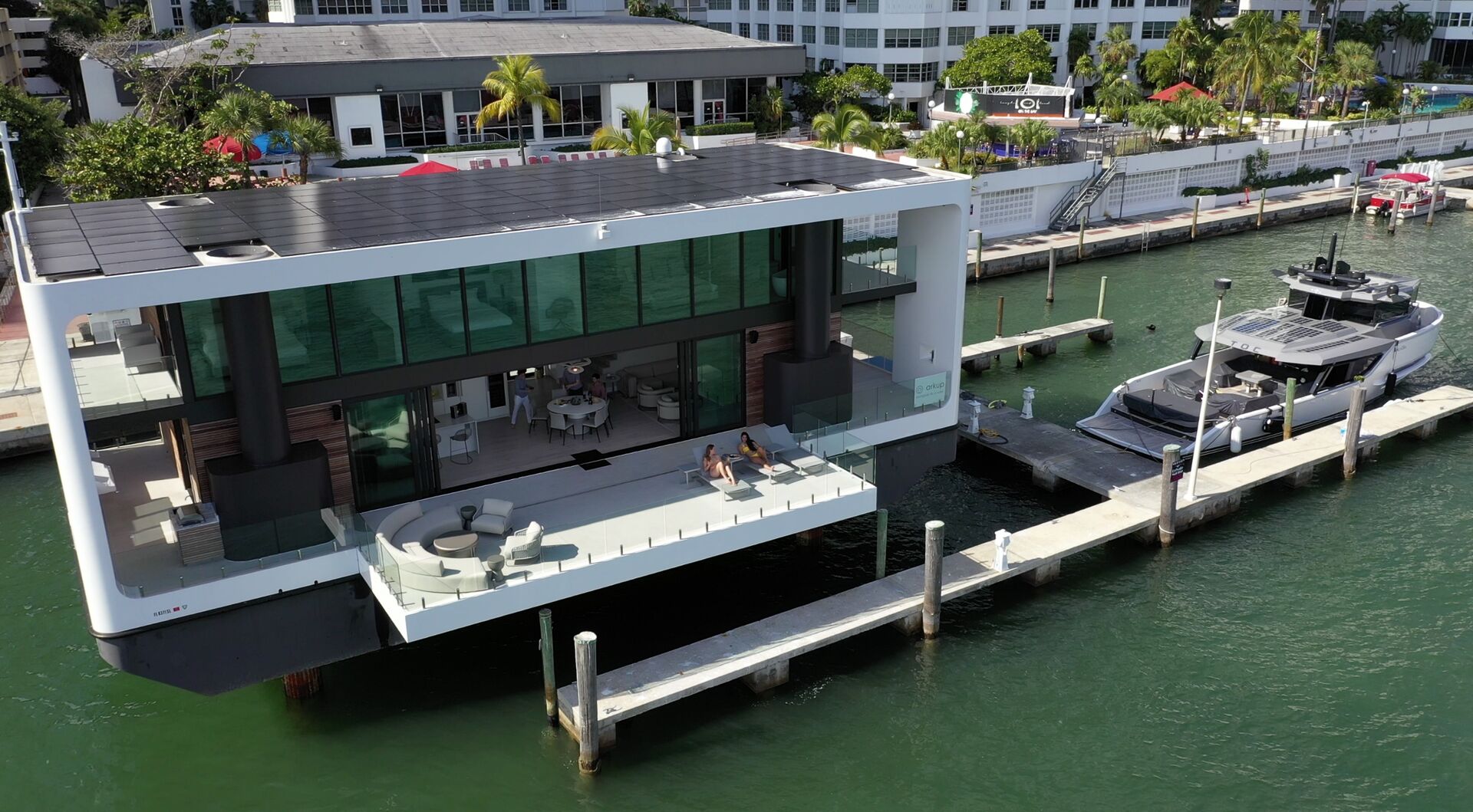
一方、気候変動の影響から水害の規模と頻度は年々増加傾向しており、2050年には海面が50cm上昇し8億人が影響を受けると予測されています。
海面上昇に対応したウォーターフロント開発や、水上に浮かせることで海面上昇に対応する「フローティングプロジェクト」が求められています。


Waterstudio.NLが設計した〈Arkup〉は、浮体式基礎と水上ジャッキアップ技術を組み合わせた次世代のフローティングアーキテクチャです。

暴風雨の際には、浮体式建物を水面から3m以上持ち上げることで、激しい波の影響を受けないようにすることができます。この安定性の向上により、マンションや高層ビルなどの大規模なフローティングストラクチャの建設が可能になります。


Waterstudio.NLのケーン・オルトゥイス(Koen Olthuis)は次のように主張します。
「世界で進む都市化と気候変動は、都市における居住性に影響を与えています。水と戦うのではなく、水とともに暮らす都市『ブルーシティ』となることで、パフォーマンスの高い都市となるでしょう。」

世界で進化を続けるフローティングアーキテクチャ、海に囲まれる日本だからこそ注目していきたいですね!





以下は、Waterstudio.NLのリリース(英文)です。
Floating architecture is on the move. Designs are getting more luxurious and quality is rising but more important the technology taking a leap.
With the completion of the Miami based Arkup portable hurricane proof villa designed by Koen Olthuis of Waterstudio a new generation of floating buildings has emerged. The evolution of floating villas has resulted in a hybrid solution that combines the flexibility of the floating foundation with the stability of offshore jack-up technology. During storms the floating building can be lifted up more than 10ft above water level out of reach of the heavy waves. This upgrade of stability performance unlocks opportunities for large scale floating structures as condominiums and floating high rise which will benefit from the additional support of the lowered spuds.
New larger urban components will accelerate the Rise of the Blue city.
Urbanization and the effects of climate change put pressure on livability in big cities. “Rise of the blue city” argues that Cities that are threatened by water today will be the best performing cities of tomorrow if they start using the water to achieve a higher flexibility and shorter response time. Stop building for today’s demands, start building for change!

The atoll nation of Maldives is creating an innovative floating city that mitigates the effects of climate change and stays on top of rising sea levels.
The Maldives Floating City is designed by Netherlands-based Dutch Docklands and will feature thousands of waterfront residences and services floating along a flexible, functional grid across a 200-hectare lagoon.
Such a development is particularly vital for countries such as Maldives – an archipelago of 25 low-lying coral atolls in the Indian Ocean that is also the lowest-lying nation in the world.
More than 80% of the country’s land area lies at less than one metre above sea level – meaning rising sea levels and coastal erosion pose a threat to its very existence.
Sustainable design
Developed with the Maldives government, the first-of-its kind “island city” will be based in a warm-water lagoon just 10 minutes by boat from the capital Male and its international airport.
Dutch Docklands worked with urban planning and architecture firm Waterstudio, which is developing floating social housing in the Netherlands, to create a water-based urban grid built to evolve with the changing needs of the country.
Maldives thrives on tourism and the same coral reefs that attract holiday makers also provide the inspiration for much of the development. The hexagon-shaped floating segments are, in part, modelled on the distinctive geometry of local coral.
These are connected to a ring of barrier islands, which act as breakers below the water, thereby lessening the impact of lagoon waves and stabilizing structures on the surface.
“The Maldives Floating City does not require any land reclamation, therefore has a minimal impact on the coral reefs,” says Mohamed Nasheed, former president of the Maldives, speaker of parliament and Climate Vulnerable Forum Ambassador for Ambition.
“What’s more, giant new reefs will be grown to act as water breakers. Our adaptation to climate change mustn’t destroy nature but work with it, as the Maldives Floating City proposes. In the Maldives, we cannot stop the waves, but we can rise with them.”
Affordable homes
The islands’ seafaring past also influenced the design of the buildings, which will all be low-rise and face the sea.
A network of bridges, canals and docks will provide access across the various segments and connect shops, homes and services across the lagoon.
Construction is due to start in 2022 and the development will be completed in phases over the next five years – with a hospital and school eventually being built.
Renewable energy will power the city through a smart grid and homes will be priced from $250,000 in a bid to attract a wide range of buyers including local fishermen, who have called the area home for centuries.
Rising sea levels
In March, the UN’s World Meteorological Organization (WMO) warned that oceans were under threat like never before and emphasized the increasing risk of rising sea levels.
Around 40% of the global population live within 100 kilometres of the coast.
WMO Secretary-General Professor Petteri Taalas said there was an “urgent need” to protect communities from coastal hazards, such as waves, storm surge and sea level rise via multi-hazard warning systems and forecasting.
Atoll nations are even more at risk than other island-based countries, with the Maldives one of just a handful – alongside Kiribati, Tuvalu and the Marshall Islands in the Pacific – that have built societies on the coral-and-sand rims of sunken volcanoes.
So-called king tides – which can wash over parts of habitable land – and the storms that drive them are getting higher and more intense due to climate change.
Connecting communities for ocean resilience
The World Economic Forum, Friends of Ocean Action and the UN Secretary-General’s Special Envoy for the Ocean will explore how to take bold action for a healthy, resilient and thriving seas during the Virtual Ocean Dialogues 2021 on 25-27 May.
The online event will focus on the vital importance of mainstreaming the ocean in global environment-focused forums and summits – from climate and biodiversity, to food and science.